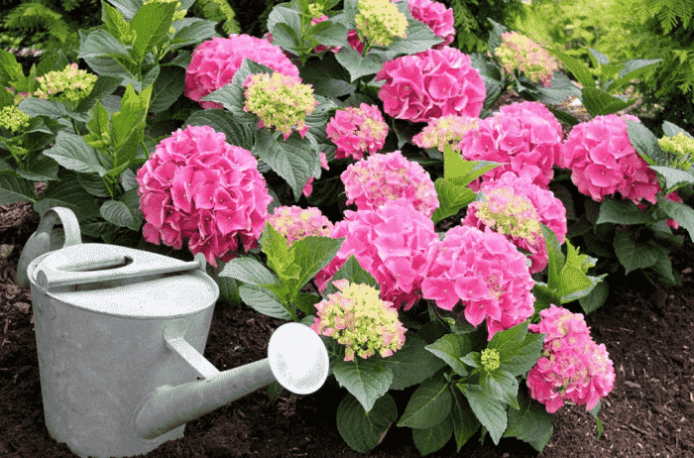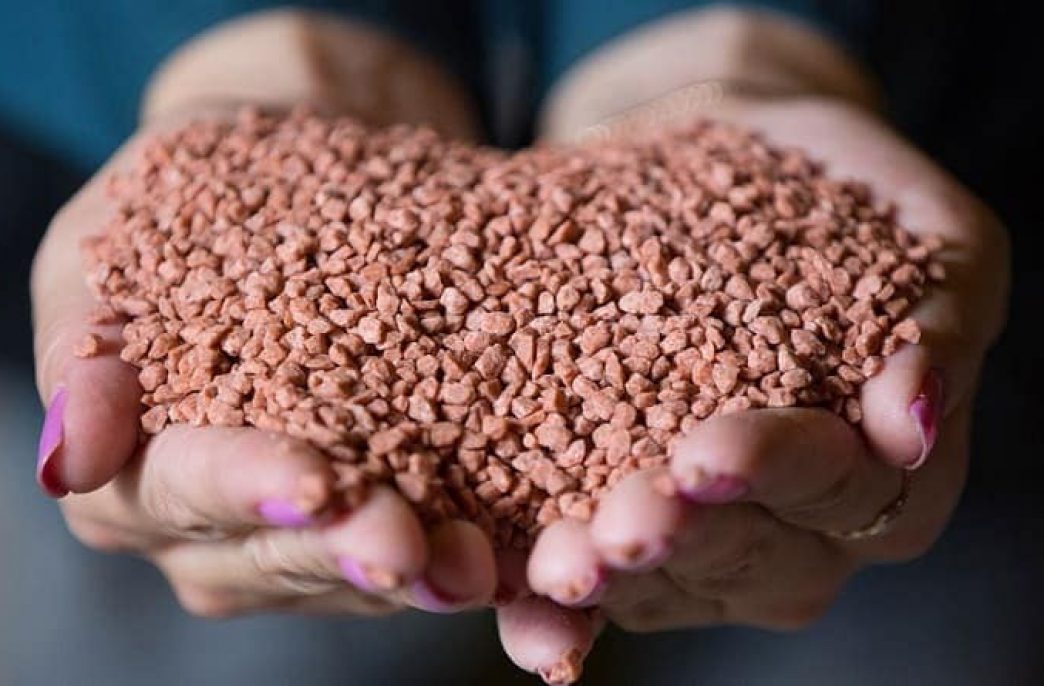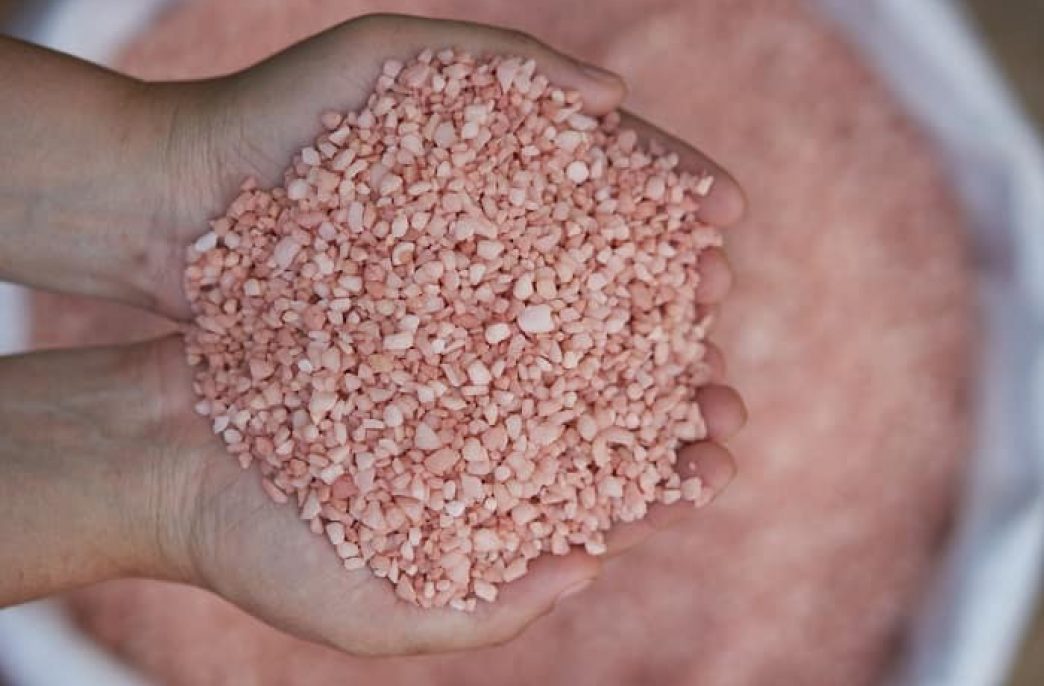How to feed a hydrangea in the spring for lush green blooms

Hydrangea is a beautiful moisture-loving plant. If you do not allow the soil to dry out and properly organize the care of flowers, you can make the flowers bloom.
How to feed a hydrangea in the spring
The plant needs macro and micronutrients, especially iron. Sour soil is best for growth. Top dressing of hydrangeas in the spring and later is carried out taking into account the need for nutrients. Buta needs:
responsible for nitrogen, green mass, succulent leaves and a set of strong buds. It is important not to overdo it, otherwise the landscaping will damage the flowers;
phosphorus provides a large number of flowers and their size, as well as the duration of flowering and wintering ability;
potassium provides the best flowering in the spring, and in the fall it is responsible for the frost resistance of the bush and provides energy for future budding;
trace elements responsible for various processes. Magnesium is important during the installation of buds and affects the brightness of flowers. Iron deficiency increases the risk of chlorosis and so on.
If the top dressing is done correctly in spring and summer, the hydrangea will like bright green leaves, timely formation of buds and long, lush green blooms. Bush is less sick and tolerates temperature changes and other adverse weather conditions.
An important addition: if you feed the hydrangea properly when planting in the hole, you will not be able to add anything to the soil for the next few years.
Mineral and organic fertilizers

There are many options for feeding hydrangeas. Some are more expensive, others are almost cheaper. Florists emphasize the need for caution for all types of hydrangeas – paniculate, tree-like and less common.
An approximate list of means of feeding hydrangeas in the spring and in the future includes:
nitrogen fertilizer. Shown only in the spring when the snow melts. If there is an excess of nitrogen in the soil, the leaves will be fertile, and flowering will be bad and fast. From mineral fertilizers you can use urea (15 g per 10 l of water), ammonium nitrate (up to 30 g per bucket of water). Chicken manure is suitable from organic matter – the concentrate is prepared by diluting the manure with water in a ratio of 1:20, for ingestion – 1: 3. You can use mulch, mulch, nettle infusion, as well as mulch bushes with humus, compost, peat;
complex mineral nutrition of hydrangea hydrogens. A suitable nitroammophoska containing 16% of each of the three main elements. Take 20–30 g of the composition in a bucket of water, pour 5 liters under each bush. For fertilization after flowering or in the fall, diammophos is used, with reduced nitrogen content and potassium and phosphorus content of 26% each. The composition is diluted to 20 g per 10 liters. Given that the listed compositions do not contain trace elements, they are added separately in the form of gums;
phosphorus-potassium compositions. Used during budding to ensure a glossy bloom. The most popular are top-superphosphate (up to 20 g per 10 l), double superphosphate (double the dose), potassium sulfate (up to 20 g per 10 l). Potassium salt or potassium magnesium is often used instead of potassium sulfate, which contains magnesium, which is useful for hydrangea;
humates. Improve the absorption of complex fertilizers by the plant.
Wood ash is not used because it reduces the acidity of the soil. If you plan to get a pink hydrangea, an exception is made.
Ready formulas

Feeding hydrangeas will not be so difficult if you use more expensive specialized formulas that contain the necessary set of micro and macro elements. Most popular celebrities:
“Fertika Crystal” with trace elements;
Agratola with humates and trace elements;
Bona Forte with vitamins, trace elements and succinic acid;
“Buy fertilizer” in granules and powders with micronutrients.
It is important to note that some formulas change the color of the plants to blue.
Hydrangea is successfully fed in the spring with formulas that have a long-lasting effect. Usually these granules are added dry around the bushes in pre-drilled holes. It is enough to add a supplement once a season, and nothing else is required.
Folk medicine
Unusual fertilizers can be used kefir. Take 2 liters of kefir, sour milk, fermented boiled milk for a bucket of water. Another option is to use a yeast solution (mix 10 L of water, 10 g of yeast and 5 teaspoons of sugar) or live beer.
You can use acidic but unsalted foods. A small pink solution of potassium permanganate is used to strengthen the captives. It prolongs flowering and enlarges flower heads. The effectiveness of improvised means loses mineral fertilizers, but they are cheaper.
The best rules of dress

Decorative flowers do not require less attention than other crops on the site. Hydrangeas do not give crops, but there are ways to change the site during its flowering. Experienced gardeners follow the following rules when feeding hydrangeas:
For the first time after winter, the fertilizer is applied when the snow is completely melted and the temperature is stable at a positive sign. When the soil is heated to +4 … +6 degrees, the roots of the flower are ready to absorb from the environment the elements necessary for growth.
Dry fertilizer for hydrangea is spread on the ground, then loosening to a depth of 5 cm, and then watering the soil.
The use of liquid solutions requires pre-moistening of the soil. The day before the introduction of the drug, the bush is well watered, so the root system does not burn, but it intensively absorbs the beneficial components of nutrition.
The dose is reduced by half compared to the watering rates for spraying the bushes on the leaves. Spraying is scheduled for the evening or on a cloudy day so that the leaves do not burn in the sun.
An overdose of the drug is also fraught with burns of the green part and roots.
Hydrangea prefers acidic soil, so fertilizers that reduce its acidity can not be used to feed the flower: manure, wood ash, and others.
Fertilization time
The first feeding of hydrangeas in the spring is designed to stimulate the active growth of plants, so it is characterized by an increase in nitrogen content. After 2 weeks, the flower is watered with a mixture that strengthens the tree. If necessary, additionally acidify the soil. Subsequent treatment is carried out in late spring to accelerate the growth of bush shoots. Approximate scheme of feeding hydrangeas:
From 10 to 18 April – nitrogen-containing drugs;
May – spraying with manganese compounds strengthens these captives and makes them flexible;
the beginning of June – a complex nutrition of plants, which contains a set of components necessary for growth and development.
How to feed a hydrangea in the spring for green flowering

The best dressing of hydrangeas in the spring is done to help the plant fully emerge from its hibernation phase. Nitrogen is responsible for greening and stimulating growth. The choice of nitrogen fertilizers depends on the budget and size of the site, as well as soil needs. The first time the bushes are fertilized about 2 weeks after the snow melts. If the soil is not sufficiently heated by that time, the procedure is postponed. At the same time help the plant with urea potassium sulfate. Dissolve 40 g of each substance in a bucket of water. For 1 landing you will need 5 liters of ready solution.
Organic substances can be used instead of chemicals. Liquid manure diluted with water in a ratio of 1:10 works well. The choice in favor of such a fertilizer for hydrangeas is advisable when growing flowers in neutral and alkaline soils. If the soil is podzolic, ammonium nitrate will help acidify it as needed.
The second time the plant feeds when the leaves are in bloom, but there are still no flowers. The need to feed with this or that type of fertilizer is determined by the appearance of the bush. If the hydrangea looks healthy, potassium-containing preparations are preferred. If you notice signs of chlorosis, nitrogen fertilization should be repeated.
The choice and method of application of the drug also depends on weather conditions. When the soil is abundantly moistened by rain, it is enough to sprinkle the dry drug under the bushes and dig the ground. In drier conditions, a liquid drug will be needed. By adhering to the conditions and rules of feeding, hydrangea will enjoy its bright color for a long time.
How to feed a hydrangea to change color
To acidify the soil and change the color of plants, use a solution of weakly acidic electrolyte (10 ml per bucket of water), apple cider vinegar (100 ml of vinegar per bucket of water) once or more times a month or dry 20-40 g in 10-40 water dissolve the citric acid. If you add ferrous sulfate or iron chelate (20 g per 10 liters of water) the benefits will be huge.
The color of the plants is regulated by adjusting the acidity of the soil – the more acidic it is, the more blue and purple shades appear. If the pH is around 6-6.2, then the flowers will be dark red or pink.
Useful tips

Only if the feeding is done correctly and precisely, the hydrangea will bloom green and bright. Basic recommendations:
before adding additives to the soil, it is necessary to retreat 20 cm from the body of the bush, make a shallow groove, pour or pour the composition, and then cover with compost, sour peat or humus;
the ground is pre-moistened, except for the period immediately after the rain;
feeding is carried out in the evening or early morning when the sun’s activity is low;
The root dressing is often used in spring, summer – on the leaves.
Leaf treatment is not a substitute for root fertilization. Time and dosages are selected taking into account the manufacturer’s recommendations, weather conditions and soil composition.




